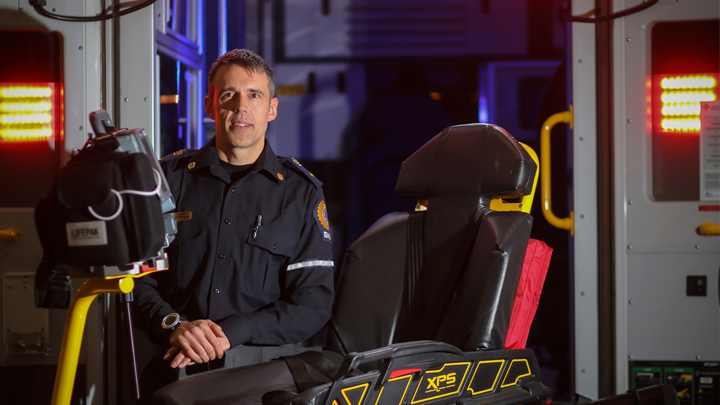

Ian Blanchard, a former paramedic and now Provincial Research Lead, helped lead a two-year AHS EMS study that observed paramedics at work in a moving ambulance to help design a safer interior for both patient and caregiver.
Story by Erin Lawrence | Photo by Leah Hennel
Ian Blanchard remembers well his final shift working in the back of an ambulance — it was the day his career caring for patients one-on-one came to an early, unplanned end.
“I was stepping over some cables that ran from the stretcher to a monitor on the side counter, and I grabbed onto the stretcher for support, but the mechanism broke and I started to fall,” recalls Blanchard. “I landed on the floor in a small stairwell that’s off to the side.”
Blanchard already had back problems, and this dramatic fall re-injured him significantly, leaving him unable to perform the physically-demanding duties of a paramedic. But with years of valuable experience, and with formal training and a passion for research, he took a new path to continue his career.
With support of senior leadership, Blanchard was able to begin building a formalized plan to put trusted research into practice at Alberta Health Services Emergency Medical Services (AHS EMS), culminating in his new role as Provincial Research Lead, attached to the Office of the Chief Paramedic.
To this end, Blanchard has come full circle — working with EMS and University of Calgary colleagues, as well as Canadian ambulance manufacturers, to redesign the interiors of ambulances to make them safer for paramedics and patients — to prevent injuries like the one he suffered. It’s work he finds very satisfying.
“I was at a research lecture at the University of Calgary and, after the talk, Dr. Bill Ghali introduced me to Dr. Jeff Caird, who is a human factors expert and at the time was designing Emergency Department resuscitation bays here in Calgary.”
From this initial encounter, the idea to take a fresh look at ambulance design emerged.
“The first step was to get our EMS team together with Dr. Caird’s team from the Ward of the 21st Century or W21C,” adds Blanchard. “We needed to figure out how to observe different paramedics providing care to the same patient, in a way that recorded what they were doing, and even where they were looking — all on a limited budget.”
Their solution? They equipped an ambulance with the latest in video technology, including special eye-gaze tracking goggles, and ran simulated scenarios as part of routine paramedic training.
When it comes to ambulance design, theirs is the first major provincial study of its kind in Canada. The information being gleaned here in Alberta is being shared with other provinces and jurisdictions across North America.
“Ambulances that are safer for paramedics are safer, too, for patients,” says EMS Chief Paramedic Darren Sandbeck. “When we’re able to reduce the likelihood of the paramedic needing to — even carefully — navigate around in a moving vehicle, there’s less risk of the paramedic being hurt during a sudden stop or evasive maneuver, and thus less risk to the patient. It’s a win-win situation.”
Funded by the AUTO21 Network of Centres of Excellence, the University of Calgary W21C Research and Innovation Centre and AHS EMS, the study — The evaluation of an ambulance rear compartment using patient simulation: Issues of safety and efficiency during the delivery of patient care — was published earlier this year in the Applied Ergonomics journal.
Over 18 months across all five AHS zones, the study observed close to 50 paramedic teams during a simulated scenario in the back of a moving ambulance.
“Until now, ambulance design has been largely focused on equipment and gear needed in the patient compartment,” says Blanchard. “This is one of the first studies done where the focus was on how paramedics actually use an ambulance when providing active care.”
“We spent nearly two years working with frontline paramedics, studying how they moved around in an ambulance, where they looked, where they tended to reach, or support themselves when they were moving around.” adds Mike Plato, EMS Associate Executive Director of Business Standards and Operations Support.
“We know that it’s safest when the paramedic can provide care from one of the three seats in the patient compartment, safely belted in — so part of what we wanted to do was see how we needed to reconfigure the area around the seats to keep paramedics from needing to get up as much. This is called Safety Oriented Design.
“These design changes come at no additional cost to AHS EMS. As the second-largest ambulance service in Canada, buying 60-70 new ambulances per year as part of a life-cycle replacement program, AHS EMS has been working directly with manufacturers — and is able to influence the design of new ambulances as they’re developed.”
In fact, changes recommended by the AHS team are already being seen in new ambulances.
Another initiative to improve employee and patient safety is the introduction of new Stryker power cots and power-load systems, which have also significantly reduced paramedic injuries. A specially designed arm, called a Technimount, allows the heart monitor-defibrillator unit — which typically is secured on a counter inside the ambulance — to attach directly to the stretcher. This means there are no trailing wires that paramedics have to step over, thus eliminating a trip hazard.
This one innovation alone might well have prevented Blanchard’s fall.
“These changes might seem slow or incremental year by year, but when you add up the total of all these changes, they’re significant,” says Blanchard.
“This study is an important example of how research and knowledge translation can inform tangible changes. I believe that AHS EMS is leading the way with these proactive upgrades — and hopefully it can prevent one of my coworkers from experiencing the same type of injury that took me off the street.”
Some of the key changes evident in newly-delivered AHS ambulances thanks to Safety Oriented Design include: